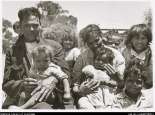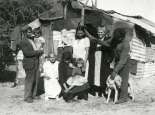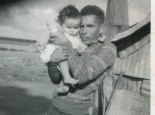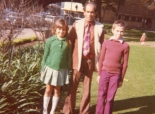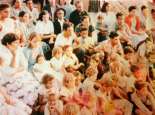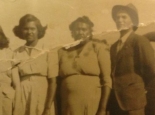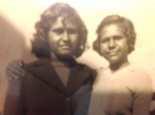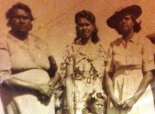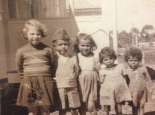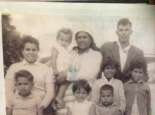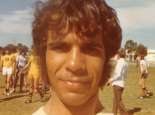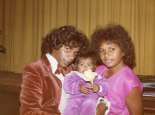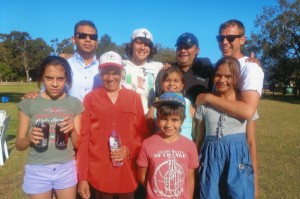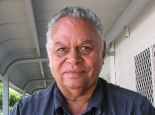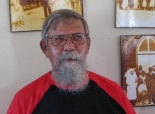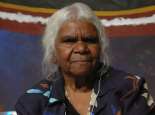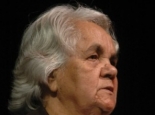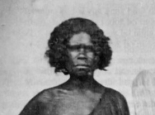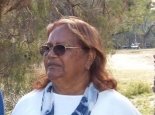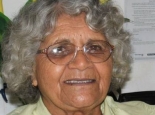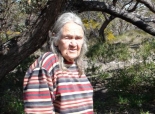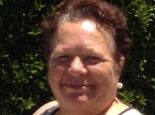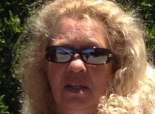Family
Noongar Words
Moort or moortung – family or relations
Demban – Grandfather
Dembart – Grandmother
Ngangk – Mother
Maam bart/maaman/naan – Father
Ngoony – Brother
Djook – Sister
Kongk – Uncle
Ngoolja – in-law
yok – female
koort/koorta mart– sweetheart or wife
Family is at the heart of Noongar culture. Our family trees are vast. Noongar ancestral connections are like an intricate system of roots, reaching back to the Dreaming or Nyitting. Our people are connected by kinships, the way stars in the sky form intricate constellations, connecting points together to form a unique shape.
I was born in Pinjarra in the 1930s. My mother was Mary Nannup who married Louis Walley. Her father was David Nannup who married Emily Jones. My father’s father was Stephen Walley who married Joanna Isaacs, which makes part of my family coming from Busselton, originally from Pinjarra. But I keep to the Pinjarra side. One of the first Aboriginal names on the Walley side was John Walley, who married Tundop. His son, another John Walley, married a Wallbanger, an Aboriginal woman. Great grandfather John and great grandmother Mary Rose Walley had a son, Stephen, who married Joanna Isaacs. They are my grandparents on the Walley side. Granny Mary Rose is buried in Pinjarra and Granny John in New Norcia.
This is when they [the Walley’s] started branching into Pinjarra and although it’s the mainstay of our family, we got relations all over but the trunk of the family tree of Walley knowledge and learning is in Pinjarra. I got this knowledge from here.
Joe Walley, RIPin Collard, Harben and van den Berg, ‘Nidja Beeliar Boodjar Noonookurt Nyininy, 2004
There are many Noongar people today who can tell you who their moort – families/relations are and some can go back several generations. Knowing your family and where you come from forms an essential part of our identity.
My name Beryl Harp (Bennell). My father was Ray Bennell and his father was Grandfather Doorum (Norman) Bennell and he married Kate Collard. My mother was Marjorie McGuire and she was the daughter of Doolak (Nellie) McGuire. She married John McGuire and he was from up north, from Onslow. Doolak well her mother was Kandianne who was married to John Monger-Bennell. I had seven brothers and six sisters. They married into the Winmar, Riley, Quartermaine and Yarran Noongar families.
Beryl Harp snr, oral history, SWALSC, 2013
In contemporary times a Noongar person who comes across another Noongar person that they might not know, they might ask another Noongar person “Ngeern barl” – who is that person or Ngeern barlah kurrlonggurr”? (Who are the parents of that child?) Or he might ask the young person directly’, “Ngeern noonar ngarnk”? (Who is your mother?) Or, alternatively, he might ask, “Ngeern noonar maam”? (Who is your father?) This would enable the person who is asking the question to understand who that person’s moort are and to also confirm their relationship and obligations (if any) to one another.
Noongar families are different from the Western ‘nuclear family’. Although they tend to be large, Noongar families are close-knit. It’s as though relations are a step closer. Noongar people have more than one mother and father, more brothers and sisters than just our biological siblings. For instance:
| Western | Noongar |
| Maternal Aunty | Mother (Gnarnk) |
| Great-Aunt (Grandmother’s sister) | Nan/Grandmother (Deman) |
| Cousins | Brothers and sisters (Ngoony and Djook) |
| Second Cousins | Cousins (Moortung – relations) |
Noongar parents often reverse roles when talking to their children. This shows that parent and child, grandparent and grandchild are equal, connected by a reciprocal relationship.
A conversation might be as follows:
Grandmother – “hello my nanna” to grandchild
Grandfather – “hey my pop” to grandchild
Mother – “here mum” to child
Father – “here dad” to child
A Noongar family will also claim the grandchildren of their brothers and sisters and refer to them as “they all my grannies”.
Aunties and Uncles will also address their nieces and nephews in this way:
Aunty – “come here my little aunty”
Uncle – “come here my little uncle”
The late Tom Bennell (Yelakitj), shared this story about moort relationship names and how the moort would have wangkiny – talked with each other:
Dembart is the name for Grandfather. I say ‘dembart yaarl koorl” – Grandfather come here
Deman is the name for Grandmother. or ‘deman yaarl koorl‘ – Grandmother come here. Wort koorl deman, that means ‘go away grandmother’.
They might go to some of their other relations, they don’t call them uncles they call them konk and their brother-in-law they call them ngoorlja.
They call their brother ngoony and sister djook.
A child is called a ‘nop‘.
A maam – man calls his yok – koorta. Koort is heart.
Cousins well they call them same – grandfather, same as their cousin, dembart
Noongar Elder Tom Bennell in Collard, Harben and van den Berg, ‘Nidja Beeliar Boodjar Noonookurt Nyininy’, 2004
Yorga and Moort (Women and Family)
Before colonisation, Noongar yorga (women) took substantial responsibility for Noongar day-to-day life. Through the harvesting of vegetables and roots, as well as hunting small animals, Noongar yorga contributed greatly to the dietary variety of their families, thereby sustaining the overall health of the community. They constructed their mia mia (shelter), made their booka (kangaroo skin cloaks) and bags from the yongka pelts (kangaroo) (Moore 1842, pp.110-111, 590). Noongar yorga were the primary caregivers for the koolangka (children) until they were old enough to join the Noongar men and learn men’s business.
Noongar yok/yorga were also important to the relations between Noongar groups from different areas. They played a pivotal part in many ceremonies, including welcoming individuals to their family’s lands. (Tilbrook 1986, pp.100-101, 556). There is a symbolic affiliation between creation sites and knowledge and the role of yok (woman). Noongar yorga (women) contributed much to their economic life by taking responsibility for a huge proportion of Noongar work. They hunted and collected much of the food, they built the family mia mia and they spun fur and hair for rope used for a variety of purposes. They took responsibility for most of the care and kaartdijin (knowledge) of the koolangka (children).
When necessary, yok would carry tools for the maam (men). The women usually had two choota (bags); one to carry the koolangka (child) or baby, and the other for food and items collected during the day’s work (Moore 1884, pp.55-56).
My name is Doolan (Leisha May Garlett) Eatts and I was born at Badjalling in 1934: My name means “strong hands” – when my grandfather died my grandmother Doolan was left a widow – three boys and three girls – and there was no benefits then and they lived on a farm in Quairading (Scotts farm). They were told they could stay and hunt and gather all their food from the farm.
Doolan Leisha Eatts, oral history, SWALSC, 2008
… my grandmother when she went hunting she had big kangaroo dogs … they would chase and hold the kangaroos down and then grandmother would come with a koorndie (large stone) and knock it in the head – now she would skin it – cut the stomach open and throw it away in the bush and she would carry the yonga back on her shoulder that is how strong she was. She would hang it on a tree and skin the yonga and cut the yonga meat up to feed the children. She would take the kids walkabout in the bush picking their berries and their quardiny, their jam off the jam trees, wild potato and the like. The quardiny is like a wild carrot they dig it up and they took it home and they would cook and eat it. It was very good in vitamins it gave them good health. I remember I used to go out with my grandmother and aunty and we used to walk for miles and they used to sit down at the rabbit warren and dig out a rabbit and they would put their hand in, they would get a stick and check and if fur was on the end of the stick they would put their hand in and pull the rabbit out. They would skin it and kill it and pull the stomach out and make a little fire and cook it if we were hungry.
If we saw the bardi trees we would dig around the roots and get the bardi and cook them too. If we saw a karda (lizard), my Aunty Florrie used to chase the karda around and hit it on the head, they would climb trees and she would chase after them and hit it on the head then we would put it on the fire and cook it and eat it.
We also bought a lot of bush food home too like yonga, the bardies, we used to dig for the carrot and wild potato. The wild potato was a funny looking thing, it had a vine sticking up out of the ground and we would follow the vine and if we broke the vine we would never find the potato. We would go right down into the ground and dig them out. We never went without the bush food.
Doolan Leisha Eatts in Harben & Collard, ‘Recording Traditional Knowledge‘ 2005
The contribution of Noongar yok/yorga (women or females) continues to be diverse and substantial. They play a primary role in nurturing and upholding the social, economic and political well-being of Noongar families. Noongar yok/yorga are, along with the Noongar maam (men) cultural and economic boodier (leaders) in Noongar society.
